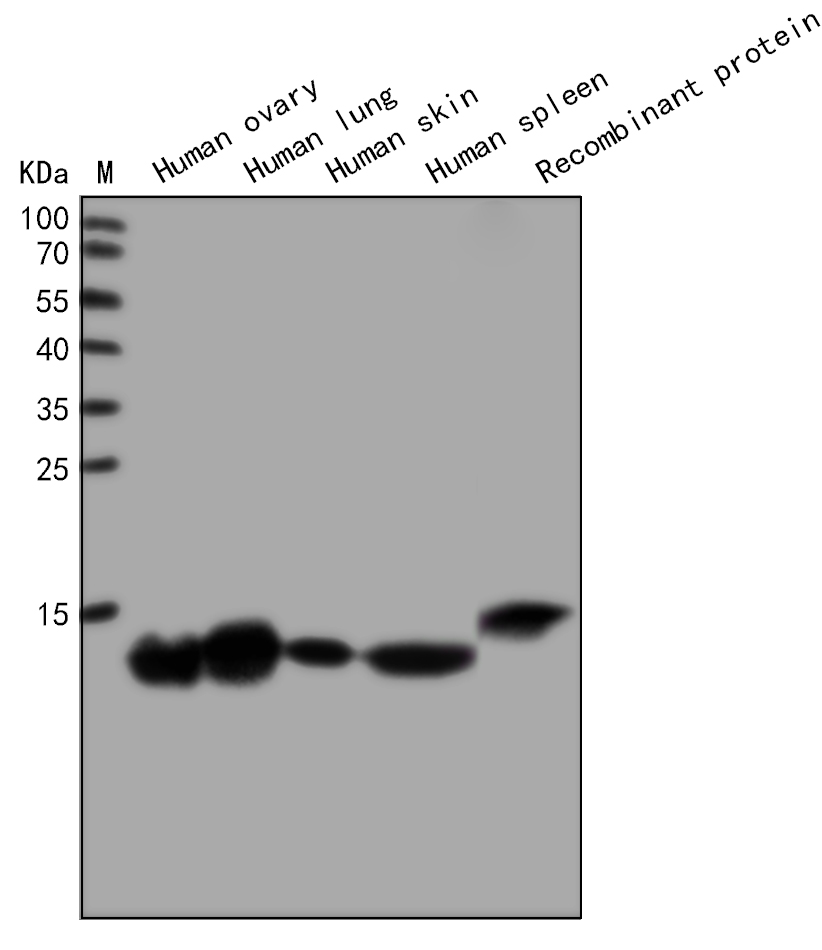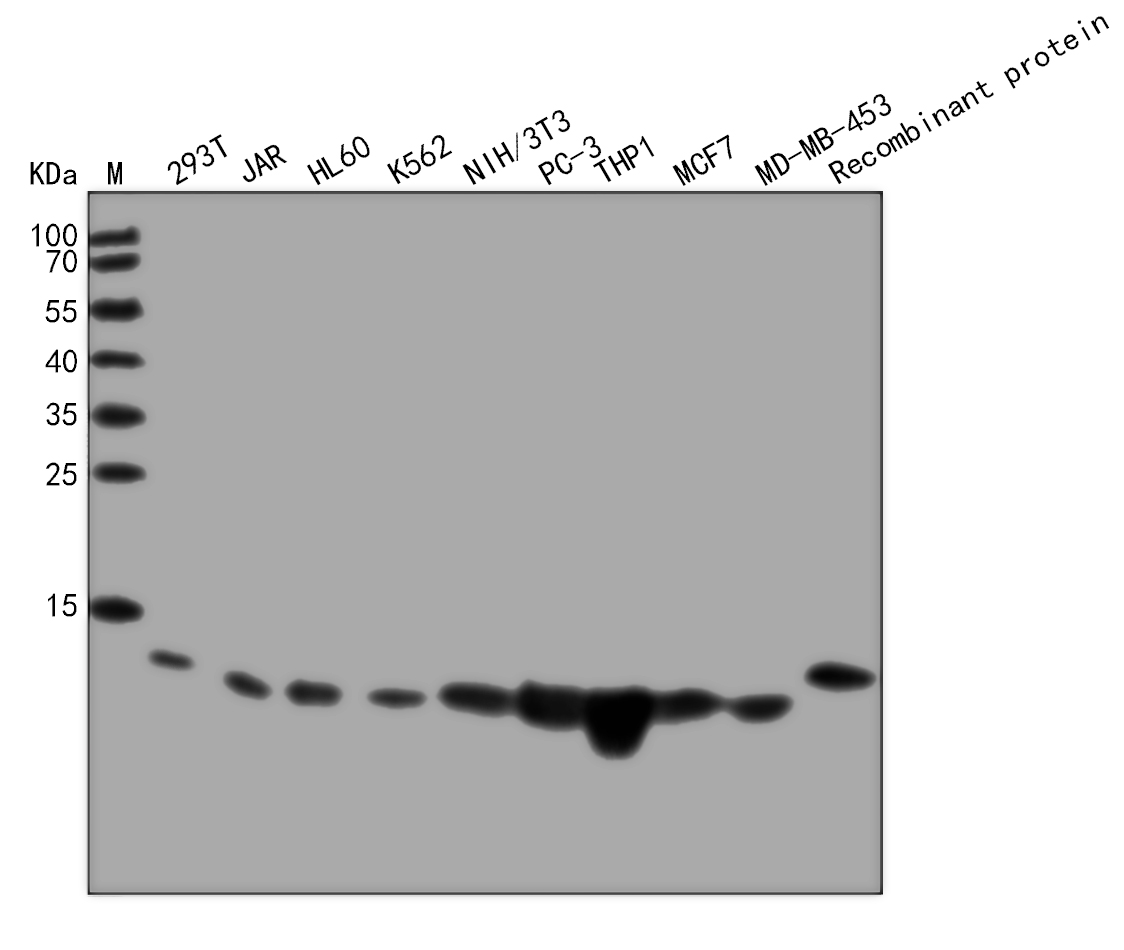
Anti-LGALS1 Antibody, Rabbit Polyclonal
产品编号:PA00691HuA10
$ 询价
规格 50uL 100uL 200uL 可选
产品名称:Anti-LGALS1 Antibody, Rabbit Polyclonal
经验证的应用:WB/ICC
交叉反应:Hu
特异性:human LGALS1
免疫原:Recombinant human LGALS1 protein, fragment Ala2~Asp135; UniprotKB: P09382
制备方法:Produced in rabbits immunized with human LGALS1, and purified by antigen affinity chromatography
来源:Polyclonal Rabbit IgG
纯化:Immunogen affinity purified
缓冲液:Supplied in PBS, 50% glycerol and less than 0.02% sodium azide, PH7.4
偶联物:Unconjugated
状态:Liquid
运输方式:This antibody is shipped as liquid solution at ambient temperature. Upon receipt, store it immediately at the temperature recommended.
储存条件:This antibody can be stored at 2℃-8℃ for one month without detectable loss of activity. Antibody products are stable for twelve months from date of receipt when stored at -20℃ to -80℃. Preservative-Free. Avoid repeated freeze-thaw cycles.
图片:
Figure1.Western blot analysis of extracts of various cell lines and tissues , using BECN1 antibody (PA00046HuA10) at 2ug/ml dilution.Secondary antibody: HRP Goat Anti-Rabbit IgG (H+L) at 1:10000 dilution.Blocking buffer: 5% nonfat dry milk in TBST.
Figure1.Western blot analysis of extracts of various cell lines and tissues , using BECN1 antibody (PA00046HuA10) at 2ug/ml dilution.Secondary antibody: HRP Goat Anti-Rabbit IgG (H+L) at 1:10000 dilution.Blocking buffer: 5% nonfat dry milk in TBST.
别称:LGALS1, GBP, HLBP14, Galaptin, Lectin,Galactoside-Binding Soluble 1, 14 kDa laminin-binding protein, Lactose-binding lectin 1, Putative MAPK-activating protein PM12, S-Lac lectin
背景信息:Galectin-1. Galectin-1, gene name LGALS1 (lectin, galactoside-binding, soluble 1), is a 135 amino acid (aa), 14 kDa, pleiotropic, non-glycosylated, monomeric or homodimeric carbohydrate-binding protein of the prototype galectin family (1-3). Galectins lack a classical signal peptide and can be localized to the cytosolic compartments, or secreted via non-classical pathways (1). Secreted Galectin-1 has immunosuppressive and anti-inflammatory properties and suppresses acute and chronic inflammation and autoimmunity. It contributes to negative selection of developing T cells, immunosuppression by regulatory T cells, resolution of the inflammatory response, and inhibition of immune cell migration, inflammatory cytokine production, and mast cell degranulation (1, 2, 4-6). Galectin-1 preferentially binds laminin, fibronectin, 90K/Mac-2BP, CD45, CD43, CD7, CD2, CD3, integrins alpha 4 beta 1, alpha 5 beta 1 and alpha 4 beta 7, and ganglioside GM1 (2, 3). It is produced in a variety of tissues by cells that include endothelial cells, connective tissue fibroblasts, thymic stromal cells, tumor cells, muscle cells, platelets, regulatory T cells, and activated tissue macrophages, B cells, T cells and dendritic cells (2, 3, 6-11). Most of this expression is cytosolic. Mouse Galectin-1 shares 88% aa sequence identity with human, 96% with rat, and 84% with equine, ovine, bovine and porcine Galectin-1. Endothelial cell surface expression, including tumor endothelial cells, is greatly increased by cell activation (9). Galectin-1 is highly expressed at the maternal-fetal interface and contributes to fetal immune privilege (5, 12). Its immunosuppressive properties appear to also allow tumor cells to evade immune detection (4, 5). It selectively controls T cell survival by inducing apoptosis of activated Th1 and Th17 cells, which express Galectin‑1‑binding glycans, while promoting Th2 cell survival where glycans are sialylated and less recognized (4, 13). It also induces apoptosis of immature thymocytes (3, 6). Galectin-1 secreted from bone marrow stromal cells aids B lymphocyte development by contributing to pre-B cell integrin adhesion and receptor signaling (3). The dimer form of Galectin-1 also induces neutrophil down‑regulation by inducing cell surface exposure of phosphatidylserine that marks the cell for phagocytosis (14). Galectin-1 can also modulate cell-cell and cell-matrix interactions, and can promote either cell attachment or detachment depending on the cell type and developmental stage (1, 2)
全称:Galectin-1 (LGALS1)
说明书:待上传
经验证的应用:WB/ICC
交叉反应:Hu
特异性:human LGALS1
免疫原:Recombinant human LGALS1 protein, fragment Ala2~Asp135; UniprotKB: P09382
制备方法:Produced in rabbits immunized with human LGALS1, and purified by antigen affinity chromatography
来源:Polyclonal Rabbit IgG
纯化:Immunogen affinity purified
缓冲液:Supplied in PBS, 50% glycerol and less than 0.02% sodium azide, PH7.4
偶联物:Unconjugated
状态:Liquid
运输方式:This antibody is shipped as liquid solution at ambient temperature. Upon receipt, store it immediately at the temperature recommended.
储存条件:This antibody can be stored at 2℃-8℃ for one month without detectable loss of activity. Antibody products are stable for twelve months from date of receipt when stored at -20℃ to -80℃. Preservative-Free. Avoid repeated freeze-thaw cycles.
图片:
Figure1.Western blot analysis of extracts of various cell lines and tissues , using BECN1 antibody (PA00046HuA10) at 2ug/ml dilution.Secondary antibody: HRP Goat Anti-Rabbit IgG (H+L) at 1:10000 dilution.Blocking buffer: 5% nonfat dry milk in TBST.
Figure1.Western blot analysis of extracts of various cell lines and tissues , using BECN1 antibody (PA00046HuA10) at 2ug/ml dilution.Secondary antibody: HRP Goat Anti-Rabbit IgG (H+L) at 1:10000 dilution.Blocking buffer: 5% nonfat dry milk in TBST.
别称:LGALS1, GBP, HLBP14, Galaptin, Lectin,Galactoside-Binding Soluble 1, 14 kDa laminin-binding protein, Lactose-binding lectin 1, Putative MAPK-activating protein PM12, S-Lac lectin
背景信息:Galectin-1. Galectin-1, gene name LGALS1 (lectin, galactoside-binding, soluble 1), is a 135 amino acid (aa), 14 kDa, pleiotropic, non-glycosylated, monomeric or homodimeric carbohydrate-binding protein of the prototype galectin family (1-3). Galectins lack a classical signal peptide and can be localized to the cytosolic compartments, or secreted via non-classical pathways (1). Secreted Galectin-1 has immunosuppressive and anti-inflammatory properties and suppresses acute and chronic inflammation and autoimmunity. It contributes to negative selection of developing T cells, immunosuppression by regulatory T cells, resolution of the inflammatory response, and inhibition of immune cell migration, inflammatory cytokine production, and mast cell degranulation (1, 2, 4-6). Galectin-1 preferentially binds laminin, fibronectin, 90K/Mac-2BP, CD45, CD43, CD7, CD2, CD3, integrins alpha 4 beta 1, alpha 5 beta 1 and alpha 4 beta 7, and ganglioside GM1 (2, 3). It is produced in a variety of tissues by cells that include endothelial cells, connective tissue fibroblasts, thymic stromal cells, tumor cells, muscle cells, platelets, regulatory T cells, and activated tissue macrophages, B cells, T cells and dendritic cells (2, 3, 6-11). Most of this expression is cytosolic. Mouse Galectin-1 shares 88% aa sequence identity with human, 96% with rat, and 84% with equine, ovine, bovine and porcine Galectin-1. Endothelial cell surface expression, including tumor endothelial cells, is greatly increased by cell activation (9). Galectin-1 is highly expressed at the maternal-fetal interface and contributes to fetal immune privilege (5, 12). Its immunosuppressive properties appear to also allow tumor cells to evade immune detection (4, 5). It selectively controls T cell survival by inducing apoptosis of activated Th1 and Th17 cells, which express Galectin‑1‑binding glycans, while promoting Th2 cell survival where glycans are sialylated and less recognized (4, 13). It also induces apoptosis of immature thymocytes (3, 6). Galectin-1 secreted from bone marrow stromal cells aids B lymphocyte development by contributing to pre-B cell integrin adhesion and receptor signaling (3). The dimer form of Galectin-1 also induces neutrophil down‑regulation by inducing cell surface exposure of phosphatidylserine that marks the cell for phagocytosis (14). Galectin-1 can also modulate cell-cell and cell-matrix interactions, and can promote either cell attachment or detachment depending on the cell type and developmental stage (1, 2)
全称:Galectin-1 (LGALS1)
说明书:待上传


